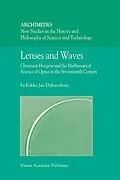In 1690, Christiaan Huygens (1629-1695) published Traité de la Lumière, containing his renowned wave theory of light. It is considered a landmark in seventeenth-century science, for the way Huygens mathematized the corpuscular nature of light and his probabilistic conception of natural knowledge. This book discusses the development of Huygens' wave theory, reconstructing the winding road that eventually led to Traité de la Lumière. For the first time, the full range of manuscript sources is taken into account. In addition, the development of Huygens' thinking on the nature of light is put in the context of his optics as a whole, which was dominated by his lifelong pursuit of theoretical and practical dioptrics. In so doing, this book offers the first account of the development of Huygens' mathematical analysis of lenses and telescopes and its significance for the origin of the wave theory of light. As Huygens applied his mathematical proficiency to practical issues pertaining to telescopes - including trying to design a perfect telescope by means of mathematical theory - his dioptrics is significant for our understanding of seventeenth-century relations between theory and practice. With this full account of Huygens' optics, this book sheds new light on the history of seventeenth-century optics and the rise of the new mathematical sciences, as well as Huygens' oeuvre as a whole. Students of the history of optics, of early mathematical physics, and the Scientific Revolution, will find this book enlightening.
Zusammenfassung
In 1690, Christiaan Huygens (1629-1695) published Traité de la Lumière, containing his renowned wave theory of light. It is considered a landmark in seventeenth-century science, for the way Huygens mathematized the corpuscular nature of light and his probabilistic conception of natural knowledge. This book discusses the development of Huygens' wave theory, reconstructing the winding road that eventually led to Traité de la Lumière. For the first time, the full range of manuscript sources is taken into account. In addition, the development of Huygens' thinking on the nature of light is put in the context of his optics as a whole, which was dominated by his lifelong pursuit of theoretical and practical dioptrics. In so doing, this book offers the first account of the development of Huygens' mathematical analysis of lenses and telescopes and its significance for the origin of the wave theory of light. As Huygens applied his mathematical proficiency to practical issues pertaining to telescopes including trying to design a perfect telescope by means of mathematical theory his dioptrics is significant for our understanding of seventeenth-century relations between theory and practice. With this full account of Huygens' optics, this book sheds new light on the history of seventeenth-century optics and the rise of the new mathematical sciences, as well as Huygens' oeuvre as a whole. Students of the history of optics, of early mathematical physics, and the Scientific Revolution, will find this book enlightening.
Inhalt
From the contents: 1. Introduction 'The perfect Cartesian'.- 2. 1653 'Tractatus'.- 3. 1655-1672 'De Aberratione'.- 4. The 'Project' of 1672.- 5. 1677-1679 Waves of Light.- 6. 1690 Traité de la Lumière.- 7. Conclusion: Lenses & Waves.- List of figures.- Bibliography.- Index.
